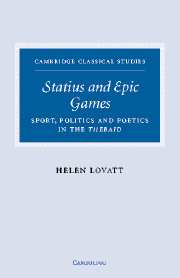6 - The sword fight
Published online by Cambridge University Press: 27 October 2009
Summary
Introduction
We have now seen the lion's share of Statius' epic games: the two remaining events (fight in armour and archery) are both in different ways non-contests. The fight in armour is stopped before it begins, and the archery is an opportunity for Adrastus to display his skill without the threat of competition. Homer and Virgil provide precedents for ending with non-competitive displays. The Iliadic games finish with a javelin competition, which Achilles stops before it starts, in order to award the prize to Agamemnon. In the Odyssey, after Odysseus has humiliated the Phaeacian boys with his prowess in the discus, they diplomatically move to a display of dancing and ball skills, which, as we have seen above (pp. 173–6), is reflected in Virgil's display event, the lusus Troiae. In a sense, Virgil also reflects the Iliadic non-contest in his archery, which is won not by the best shot but by Acestes' omen, as we will see in chapter 7. In his non-contests, Statius is also engaging with this tradition. Each raises different issues, and we will begin by exploring the fight in armour in the context of gladiatorial games.
Gladiatorial spectacles have fascinated scholars as well as film-makers. Social historians have tried to determine why they were so popular and all-pervasive in Roman culture of the imperial era. Critics of Latin poetry, and epic in particular, have looked to them as a counterpart or even an inspiration for the spectacles of blood and violent death which progressively come to dominate Latin epic. How do Statius' games fit into the reality of the arena? What of actual representations of gladiatorial fights? Silius has a bona fide gladiatorial contest in his games in Punica 16.
- Type
- Chapter
- Information
- Statius and Epic GamesSport, Politics and Poetics in the Thebaid, pp. 243 - 276Publisher: Cambridge University PressPrint publication year: 2005

